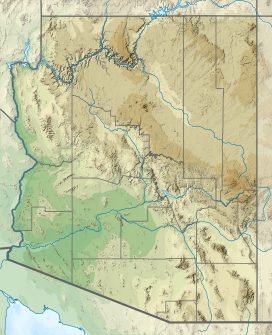Sierra Pinta


The Sierra Pinta or Sierra Pintas (colloquial Spanish for 'Painted Mountains') are a narrow remote block faulted northwest-southeast trending mountain range, about 22 miles (35 km) long located in southwestern Arizona in the arid northwestern Sonoran Desert, just north of the Pinacate Reserve of northern Sonora, Mexico. The mountains derive their name from visitor descriptions of its multicolored hues when viewed at sunrise and sunset.
The north end of the range contains the peak called Point of the Pintas at 1,272 feet (388 m), then Bean Pass; adjacent southward is the peak Isla Pinta, at 2,008 feet (612 m), and Sunday Pass. The Sierra Pinta range is toward the southern end of the Mohawk Valley, which also borders the range on the east, and east to the Bryan Mountains. West of the Sierra Pintas is the Tule Desert, and south in northern Sonora is the El Pinacate y Gran Desierto de Altar, the extensive and active volcanic and cinder cone field and preserve. The highest peak in the range is Pinta Benchmark at 2,950 feet (899 m).
An early noting of the existence of the Sierra Pinta Range was in the explorations of Anza.[1]
Roads and the region
West of the northwest end of the Sierra Pintas, the north–south "Christmas Pass Road" goes south from Interstate 8 and through Christmas Pass, adjacent to the Tule Desert, on the southeast end of the Cabeza Prieta Mountains (all to the southwest of the Sierra Pintas). The road terminates close by at the US-Mexico Border at an unimproved road called the El Camino del Diablo, or Devil's Highway, which parallels the border. This is a no man's land region in the high point of summer heat.
Ecology
The Sierra Pintas lie in the central-western portion of the Cabeza Prieta National Wildlife Refuge. The closest access point from the north is Mohawk on Interstate 8 in Arizona, through the Barry M. Goldwater Air Force Range. Ajo, Arizona is 35 air miles eastward beyond two mountain ranges and valleys; Sonoyta, Sonora is slightly southeastward at the south border crossing of the Organ Pipe Cactus National Monument.
See also
- Valley and range sequence-Southern Yuma County
- List of mountain ranges of Yuma County, Arizona
- List of mountain ranges of Arizona
References
- C. Michael Hogan. 2009. California Fan Palm: Washingtonia filifera, GlobalTwitcher.com, ed. Nicklas Stromberg
- Herbert Eugene Bolton, Francisco Palóu, José Joaguín Moraga, Juan Díaz, Pedro Font, Francisco Tomás Hermenegildo Garcés, Tomás Eixarch. 1966. Anza's California expeditions, Published by Russell and Russell[ISBN missing]
Line notes
- ^ Herbert Eugene Bolton et al. 1966
- v
- t
- e
(Yavapai County)
- Boundary Cone
- Fortification Hill
- Mount Wilson
- Mount Union
- Castle Dome
- Carr Peak
- Miller Peak
- Aubrey Peak
- Hualapai Peak
- Lime Peak
- Mae West Peaks
- Four Peaks
- Mount Ord
- East End
- McDowell Peak
- Mount McDowell
- Thompson Peak
- Mount Ballard (Arizona)
- Camelback Mountain
- Mummy Mountain
- Piestewa Peak
- South Mountains
- Sunnyslope Mountain
- Ibex Peak
- Agassiz Peak
- Doyle Peak
- Fremont Peak
- Mount Bigelow
- Mount Lemmon
- Pusch Ridge
- Thimble Peak
- Mount Hopkins
- Mount Wrightson
- Mount Turnbull
- Mistake Peak
- Granite Mountain
- Black Dome
- Sentinel Peak
- Tumamoc Hill
- Apache Peak
- Black Mesa (Navajo County)
- Escudilla Mountain
- Mount Baldy
- Agathla Peak
- Agua Caliente Mountains
- Agua Dulce Mountains
- Antelope Hill
- Aquarius Mountains
- Artillery Mountains
- Atascosa Mountains
- Aubrey Hills
- Baboquivari Peak
- Balakai Mesa
- Beaver Dam Mountains
- Belmont Mountains
- Bill Williams Mountain
- Bitsihuitsos Butte
- Black Hills (Greenlee County)
- Black Mesa (Apache-Navajo Counties)
- Black Mesa (Warm Springs)
- Black Mountain (Maricopa County)
- Black Mountain (Pima County)
- Blackjack Mountains
- Bryan Mountains
- Buckskin Mountain (Arizona-Utah)
- Buckskin Mountains (La Paz County)
- Bush Head
- Cabeza Prieta Mountains
- Canelo Hills
- Carrizo Mountains
- Cerro Colorado Mountains
- Chocolate Mountains
- Copper Mountains
- Coyote Mountains
- Date Creek Mountains
- Dome Rock Mountains
- Dos Cabezas Mountains
- Etoi Ki
- Excalibur
- Galiuro Mountains
- Gavilan Peak
- Gila Bend Mountains
- Gila Mountains (Graham County)
- Gila Mountains (Yuma County)
- Goldfield Mountains
- Grand Wash Cliffs
- Granite Mountains
- Granite Wash Mountains
- Growler Mountains
- Gu Achi Peak
- Guadalupe Mountains
- Harcuvar Mountains
- Harquahala Mountains
- House Mountain
- Hunts Mesa
- Isis Temple
- John the Baptist Mountains
- Juniper Mesa
- Kaibab Plateau
- Kofa Mountains
- Laguna Mountains
- Las Guijas Mountains
- Lime Mountain (Maricopa County}
- Little Harquahala Mountains
- Little Rincon Mountains
- Lukachukai Mountains
- Madrean Sky Islands
- Mescal Mountains
- Mineral Mountains
- Moccasin Mountains
- Mohave Mountains
- Mohawk Mountains
- Mount Trumbull
- Muggins Mountains
- Mustang Mountains
- Navajo Mountain
- The Needles
- New River Mountains
- New Water Mountains
- Newton Butte
- Painted Rock Mountains
- Pajarito Mountains
- Patagonia Mountains
- Peacock Mountains
- Picacho Peak
- Picketpost Mountain
- Pinnacle Peak
- Poachie Range
- Poston Butte
- Rawhide Mountains
- Sacaton Mountains
- San Luis Mountains
- Santa Maria Mountains
- Sevenmile Mountains
- Sierra San Antonio
- Sierra Estrella
- Sierra Madre Occidental
- Sierra Pinta
- Silver Bell Mountains
- Squaw Tits
- Sugarloaf Mountain
- Sunset Mountains
- Swisshelm Mountains
- Tempe Butte
- Temple Butte
- Tinajas Altas Mountains
- Tordillo Mountain
- Tortolita Mountains
- Trigo Mountains
- Tule Mountains
- Tumacacori Mountains
- Virgin Mountains
- Vulcan's Throne
- Vulture Mountains
- Waterman Mountains
- Weaver Mountains
- West Silver Bell Mountains
- White Tank Mountains
- Wickenburg Mountains











